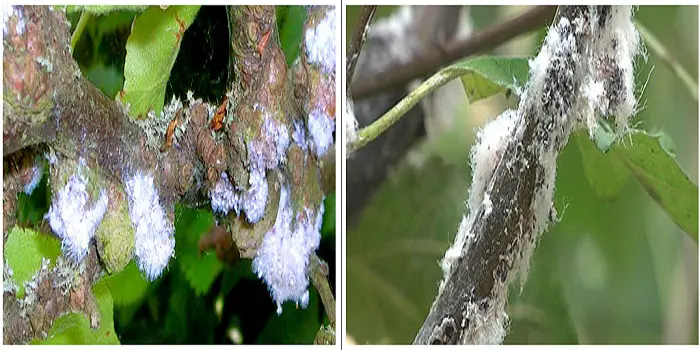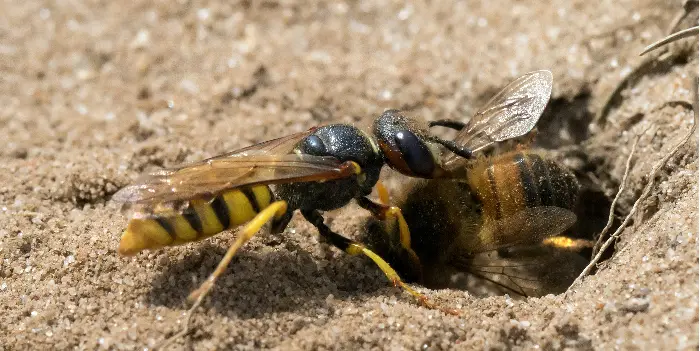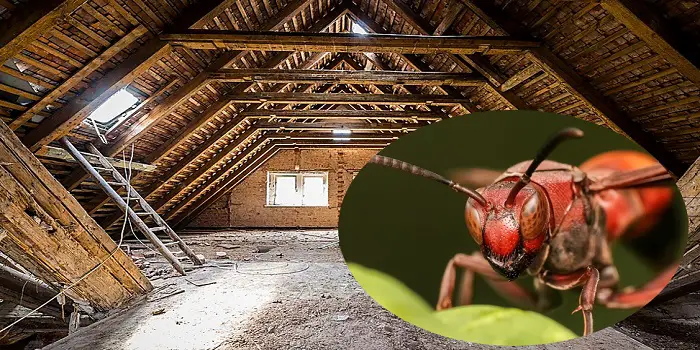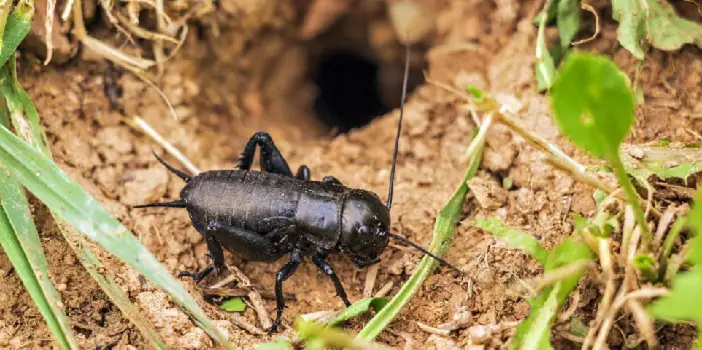
When you notice small bits of cotton-ish fluffs floating in your garden during a sunny fall afternoon, then it isn’t snow but woolly aphids.
Though they usually don’t overpopulate a place but do become an infestation sometimes.
They may damage the plant leaves in your garden and end up leaving a sticky residue on trees.
If you notice one or more aphids in your yard, they may not be enough to damage your trees and garden.
But an aphid colony can be destructive to plants.
They pierce leaves and plants through their small mouthparts and suck saps.
You can easily get rid of small numbers by hand, but a large woolly aphid population in your orchid yard may require unique removal techniques.
What are Woolly Aphids?
Just like the other kinds of aphids, woolly aphids are sap-sucking pests from the insect family.
Woolly aphids are of about ¼ inch size.
Though they are usually blue or green in color, they may look fuzzy because of the white, sticky material which covers their body.
This covering on their body looks much like cotton or wool.
Generally, these insect pests need two hosts: first for overwintering and laying eggs during spring and second for feeding during summer.
Signs of Woolly Aphid Infestation
Woolly aphids usually feed on plant sap in groups.
Especially they love feeding on apple and olive trees but can also be seen eating buds, bark, twigs, foliage, or roots.
Damage can be noticed by the curled or twitched leaves, yellow color of foliage, undergrowth of plants, growth of cankers and galls on roots or limbs, and branch dieback.
You can see wax accumulation along with sticky residue called honeydew.
Also, you may notice some plants covered with perennial canker and sooty mold – usually a black fungus which looks like soot.
Though it doesn’t damage the plant on its own, eliminating aphids and honeydew will help you in preventing sooty mold.
There are a number of signs which reveal that woolly aphids are attacking your plants. Some of them are given below:
a) Discoloration of leaves
While sucking saps from the plants, the aphids take the nutrients too.
They lead to undernourishment of the plants, and hence you see discoloration of leaves.
The higher the aphids attack and suck sap, the more the leaves will turn yellow and twist.
b) Honeydew and other growth on plants
Just like the other aphid species, they also leave honeydew behind.
If you notice sticky residue on your trees and leaves, then you can know it is them!
Honeydew attracts other insect pests too.
Hence you may notice a sudden rise in them which can be a sign that woolly aphids are attacking your plants.
You may notice the growth of galls and cankers on your plants because of woolly aphids.
Hence, make sure you notice such growths. If you notice any of these, you will know there are woolly aphid pests around.
c) Clusters of wool-like substances on plants
If you notice white fluffy clusters on your plant’s branches and stems, they are woolly aphids.
They are still when in the group, so they may get mistaken for something else.
In order to ensure, just hold a stick and tap on the sides of the branch or stem they are sited on.
If there is any movement in the group, your suspicion will get confirmed.
How to Eliminate Woolly Aphids on Trees?
Woolly Aphid may cause heavy damage to your garden plants if left uncontrolled.
Hence you should take instant action against them.
Here are some tips to help you get rid of them:
1- Blast aphids away
The very first thing you can try is to blast the apple aphids away with the help of a hose and water.
Once you have found the infested branches in your orchid, just connect the garden hose to a high-flowing water source and spray from one plant to another.
Make sure you blast the top and underneath leaves.
Also, blast on the branches and stem to remove them from the plants.
Woolly Aphids usually nest in clusters, so you can easily find them.
Though they may lodge under the leaves and make it difficult for you to notice, if you do a thorough hosing, then all the clusters will blast away no matter whether they are visible or not.
The only problem with this method is, that it is not a permanent remedy.
It is because the high flowing water just dislodges them but doesn’t kill them.
With time, they will climb again on the plants and start from where they left.
2- Cut down infected branches
Fortunately, woolly aphids don’t cover the whole plant in one go. They travel from one branch to another over time, as long as there is enough sap that can be sucked.
You should therefore go around your garden and analyze every plant to notice if there are any woolly aphid collections on the branches.
If any infested branches are damaged by aphids severely, just prune these branches off and dispose of them properly.
The perfect disposal method is to burn the infected branches as it kills the aphids that may be hanging on the branch, even after they have been cut off.
Collect all the branches chopped into a pile and take them to a location that is suitable for burning.
Before burning ensure that you have the right knowledge of the regulations about lighting fires in your state.
Make sure you stick to all the safety measures before burning the infected branches and also inform your neighbors about it.
Remember, you should only chop aphid-infected branches if the damage caused by aphids isn’t repairable.
If the infected branches are not dead yet, you can use other methods to help you get rid of aphids!
3- Lower the soil nitrogen
If you keep your soil nutrients balanced, there are fewer chances of getting an aphid infestation in your garden.
Make sure you don’t use too many nitrogen fertilizers as high nitrogen content in the soil can attract woolly aphids.
It is suggested to use natural organic fertilizers for better soil quality and effective growth of plants.
Some natural fertilizers comprise decomposed manure, liquid seaweed, and fish emulsion, which enter the soil slowly.
This makes your garden soil get constant, natural balance and the right levels of nitrogen.
4- Release natural predators
Another remedy to get rid of woolly aphids is to release some natural predators in your orchid.
They will not just eat the woolly aphids but their eggs too.
Plus, these natural predators can also control the growth of other insect pests in your garden.
Some of the predators which help in growing aphid activity are bees, butterflies, ladybugs, hoverflies, parasitic wasps, lacewings as well as praying mantis.
You can invite these predators to your yard by making your garden plants bloom appropriately.
You can also buy some of these if you want from the market.
Ladybugs for example are easily available commercially; you can just buy as many as you want and leave them in your garden.
5- Spray mild chemical solutions
Mild chemical solutions to control woolly aphids are another great way to work.
Some of these solutions include:
a) Neem oil
Neem oil works as a natural weapon against aphids on your flowering plants and trees.
These oils are made from the seeds of the neem trees and can cause great damage to these insect pests.
Neem oil works by affecting the feeding and reproductive hormones of these pests and reducing their ability to grow, eat or reproduce.
You can purchase a neem oil insecticide and spray it on infected branches and stems.
The woolly aphids will be dead in just a few days when eating the saps of the neem-covered plants.
A major benefit of using neem oil to get rid of woolly aphids is that it isn’t hazardous at all.
It is in fact secure to be used on garden plants, apple trees, olive trees, etc. Plus it’s also harmless to humans and pets.
b) Rubbing alcohol
You can also purchase solutions like rubbing alcohol and apply it to get rid of woolly aphids.
Put it on a clean cloth and rub it on the infected branches and stems to get rid of aphids.
Just be cautious while using them, as it can also kill the advantageous predators of your garden.
c) Insecticidal soap spray
Insecticidal soap spray can be purchased from a retail store in your locality, or you make one on your own.
To prepare this natural homemade bug killer for plants, you just need to mix mild liquid soap with white vinegar and water.
If you want you can consider adding a pinch of cayenne pepper to make the solution more effective.
Stir it completely in a container and put it in a spray bottle.
Now check out the affected plants and spray on them.
The surfactants present in the soap solution will dry out aphids without harming the plants.
You can spray it every 3 to 4 days till the woolly aphid population gets low.
Besides the above, a few other mild chemicals that can be used to disinfect your yard of woolly aphids are Bifenthrin, pyrethrum, malathion, Permethrin, and imidacloprid.
What Plants are Aphids Attracted To?
Aphids are attracted most to mustard and nasturtium.
That’s why many gardeners plant these near their valuable plants as a trap for the aphids.
If you are using these plants as a trap, keep a check and remove them regularly as they can jump to other plants very easily.
Few other aphid trap plants include zinnias, dahlias, cosmos, and asters.
What are the plants that deter them most?
Aphids are repelled most by catnip but can be kept at bay by pretty much any plant that has a strong, pungent odor.
Some of these aphid-repelling plants include those in the allium family, like garlic, chives, and leeks.
Few other aromatic deterrent plants that can be used for keeping aphids off are onions, sage, oregano, and ginger root.
You can consider planting them around the vicinity of your other valuable plants.
How to Get Rid of Aphids On Petunias And Roses?
Besides fruit trees, aphids can feed on tomatoes, milkweed, and a variety of other plants like roses and petunias.
When eating any such produce (from your garden or from the store), it’s essential that you wash them thoroughly.
You can use certain types of homemade aphid killer recipes to eliminate aphids on roses and other flowering plants.
1- Essential oils
And the good thing is you can easily prepare this homemade aphid sprayer solution for roses with a blend of essential oils.
- Take a glass bottle sprayer
- Fill with water and add a drop of each cedar oil, rosemary oil, clove oil, orange oil
- Shake the bottle well and spray the solution over rose bushes to kill the existing aphids and repel future bugs
Keep in mind that you should not apply any concentrated essential oil directly to roses to eliminate aphids and mealybugs.
You should only spray it after diluting with water, or it can kill/burn the plant.
2- Garlic Oil Spray
Garlic contains sulfur that pests find toxic and cannot withstand.
To prepare your natural garlic oil aphid killer solution…
- Add 2-3 cloves of garlic to the vegetable oil
- Let it sit for a day and then strain the garlic
- Add the remaining oil to some water and mix a bit of dish detergent
- Stir this mixture nicely and pour it into a spray bottle
You can now spray this solution on the plants infected by aphids.
The only downside of using this garlic-based pesticide is it can kill certain beneficial insects like ladybugs.
So, it’s good to use this spray only if there are no ladybugs in your garden.
3- Tomato Leaf Spray
Tomato leaves contain alkaloids which is again a toxic compound for aphids.
- Chop the leaves and soak them in water for a night
- Drain the leaves out and then add some more water
- Mix it well and fill the solution in a spray bottle to use as an aphid killer sprayer
This solution is not harmful to other plants or animals around.
But if you are allergic to tomatoes, you should try other options mentioned above.
Other Related Questions:
Types of aphids?
Aphids (also called plant louse, greenfly, or ant cow) can be serious plant pests, and there are more than 5,000 species known.
Although not all these species feed on plants, there are certain types that feed on only one type of plant.
Others are known to be generalists which means they can feed on various plant groups.
Do wooly aphids bite?
These are garden pests that are not harmful to humans simply because they do not sting or bite.
But as they can be damaging for fruit trees (such as apple and olive trees), you should get rid of them in your garden as soon as possible.
Are aphids and mealybugs the same?
Aphids, mealybugs, and scales are the most common sap-sucking insects you will find in the garden.
These sap feeders insert their beaks into leaves, stems, and roots to suck plant juices.
Unlike aphids (that appear as tiny sap-sucking green insects), mealybugs pretend to be kind of fluffs which makes them easier to miss out.
You will only discover the mealybugs only when they have turned the whole plant pale.
The Conclusion
The ideal way to keep woolly aphids at bay is to maintain your apple and olive trees in their prime condition.
Make sure you use natural organic fertilizers to lower the occurrence of high nitrogen in the soil.
Also, chop down the branches as and when to control the aphid population in your garden.
If required, use chemicals or predators.
This way, you can just relax and let nature’s creatures deal with these woolly pests.
Share the post "How to Control Woolly Aphids on Apple and Olive Trees?"

Welcome to ProShieldPest.com. I am Tina Jones. I have been working as a pest removal professional in Winslow, Arizona lately. At present, I love to spend my time with my family as a retiree.
Here I share all my knowledge and experiences to help people understand better how they can stop pests at their homes without actually killing them. Hopefully, the information you will find here will help in safeguarding your home! You can check more about me here.




